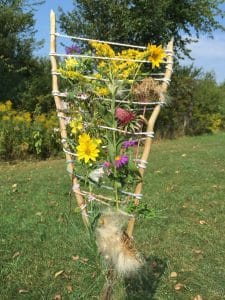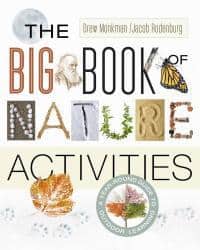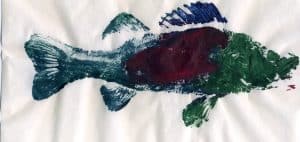With summer upon us, finding things for kids to do can be a challenge. This week, I’d like to propose a few activities from the new “Big Book of Nature Activities”, which I co-wrote with Jacob Rodenburg of Camp Kawartha. We’re confident that many of the activities will be fun for adults, as well! For more information on the book, go to www.drewmonkman.com
Scent Trail
You’ll learn: How animals follow scent trails
You’ll need: Lemon, almond, mint, maple or orange extract, blindfolds
Background: Unfortunately, our human nose isn’t sensitive enough to follow natural scent trails. However, many other mammals can. Canids (or members of the dog family) have an incredible sense of smell – many thousands of times better than humans. We might say, “hmmm mac and cheese.” Canids, on the other hand, might say, “Hmmm noodles and cheese and butter and salt and milk and bread crumbs and metal pot and Aunt Marge must have just made this!”
Procedure: In this game, you’ll be given a “helping nose” so that you can follow a scent trail to a reward at the end. Work in partners. One person is blindfolded while the other lays down a scent trail with extract. You only need a drop or two every foot or so for about 30 feet (10 m). Try to lay down a curving trail to make it more challenging. At the end of the scent trail, place a wrapped candy. Guide the blindfolded partner to the beginning of your trail and let them use their nose to find the reward at the end.
Nature Table
A simple, on-going activity is to set up a nature table in your home or cottage. You may wish to label some of the items you display. See if you can find some of the following: leaves of different sizes, shapes, edges, textures, and shades of green (preserved between 2 sheets of clear Mactac plastic); a bracket fungus from a tree trunk; egg fragments from turtle nests that have been dug up by a predator; different types of cones, seeds, berries; a vase of roadside wildflowers; dragonfly exuviae (cast skin); dead insects like dragonflies or butterflies that you come across; “scent bouquet” of wild bergamot, milkweed flowers, etc. You can also set up a glass bottle terrarium for temporary “guests” like a toad or salamander.
Pirate Eye
While sitting quietly outdoors, shut one eye and cover it with your hand for about three minutes. Observe the scene through your one open eye. Notice anything? You’ve lost depth perception! After three minutes, switch between your eyes, opening one, then the other. Do this repeatedly. The shades of colours will have completely changed between your eyes. That is because one pupil (the black spot in the middle of your eyes) dilated — got bigger — when you closed it. When you open your eyes again, the world looks brighter through this eye. The other eye, with a smaller pupil, creates darker shades. So which color is real? Do you think all humans see exactly in the same shades? As visual creatures, we humans can distinguish over two million shades of colour.
Fish Prints
You’ll learn: The patterns and scale structures of different kinds of fish.
You’ll need: A whole fish, a newspaper, acrylic paint, paintbrushes or rollers, paper towels, paper (e.g., tissue paper, construction paper, rice paper, paper plates), fabric (e.g., T-shirt). • Background: Gyotaku, or fish printing using rice paper and ink, originated more than 100 years ago in Japan as a way for anglers to record the size of their catch.
Procedure: Cover the work area with newspaper. Wash off any mucus on the fish and pat dry with paper towels. Place the fish on the newspaper. Slather paint all over the exposed side of the fish using rollers or brushes. Make sure you cover one entire side of the fish. Place a sheet of paper or fabric (e.g., T-shirt) over the fish and press it down firmly, being careful not to move it. Smooth down. Carefully remove the paper or fabric and allow to dry. You can use the fish again for another print. Just carefully wash off all of the paint under a tap.
Natural Perfume
Collect leaves, flowers and buds that are strongly scented (e.g., milkweed flowers, lavender flowers, mint leaves, wintergreen leaves, balsam poplar buds) Chop into small pieces until you have enough to fill a measuring cup. Empty the pieces into a bowl and add a cup of water. Let the mixture sit overnight. Strain the water through a coffee filter and into a clean spray bottle. Spritz over yourself and your friends and enjoy the sweet scent!
Firefly Fun
You’ll learn: How to attract fireflies and make a natural night “light”
You’ll need: Flashlight, glass jar, ice cream tub with lid.
Background: The firefly is a beetle with a special organ in its abdomen capable of mixing oxygen, a pigment called luciferin and the enzyme luciferase. When the insect flies upward, these chemicals mingle and create a flash. As the insect descends, the flash turns off. When a female of the same species sees the flash, she responds with her own light signal. Eventually the male and female fireflies find each other and mate.
What to do: On a summer evening, just as dusk fades into night, visit a meadow where there are fireflies. If you have a flashlight or a wristwatch that glows in the dark, try reproducing the pattern of flashes. Different species of fireflies flash at different rates. Like Morse code, each pulse of light communicates a special message to the opposite sex. Can you attract a firefly by imitating the sequence? You might also wish to make a “night light” for your bedroom. Catch several fireflies in a plastic ice cream tub and transfer them to a glass jar with a lid. Add a few leaves and a drop or two of water. Lie in bed and fall asleep to their lovely star-like flashes. Let them go in the morning.
Plant Weaving
You’ll learn: To create inspiring art by using the vibrant colours of summer.
You’ll need: A forked branch, string or wool, flowers, leaves, grasses, small evergreen boughs.
What to do: Find a sturdy forked stick about as wide as your thumb width and 20–28 in. (50–70 cm) long. Wrap string or wool between the forks approximately every inch (2 cm). Weave the plant material through the crisscrossing string. You’ll be amazed at the color, texture and form of your creation.
Try this: Collect natural objects (e.g., leaves of various shapes, sizes and colors; twigs; seeds; acorn caps; evergreen needles; berries; shells) and use them as building blocks to make caterpillars, leaf bugs, flowers, spiders and more. Use your imagination!
Pond Study
You’ll learn: Some of the intriguing invertebrates that live in ponds.
You’ll need: Pail (preferably with a lid), small aquarium or large glass bottle, small plastic viewing jars, fine-meshed net, shoes you can get wet, hand lens, guide to aquatic invertebrates (go to: http://www.lakesuperiorstreams.org/understanding/benthos_ID.html)
Background: Some of the common invertebrates found in ponds, swamps or streams include mayfly larvae, caddisfly larvae (usually in cases of plant material), damselfly nymphs, dragonfly nymphs, giant water bugs, water striders, water boatmen, backswimmers, leeches and crayfish. Tadpoles, frogs and aquatic salamanders may live here, too. All are easy to catch. What to do: Take your pail, plastic containers and net to a nearby pond, swamp or shallow stream. Either from the edge or by wading out into the water (no more than knee-deep), dip your net down into the dense aquatic vegetation where many creatures hang out. When you catch something like a “wiggling bug,” put it in your pail. Add a little aquatic vegetation to the pail, too. Continue until you have a variety of different creatures. Try different parts of the pond, including the muddy bottom. Don’t pour mud into the pail, however. If you are catching creatures in a stream, many will be attached to the underside of rocks. Gently push them off the rock and into the pail. Don’t be afraid to hold the creatures briefly in your hand. When you have caught a nice variety of different invertebrates, transfer a few to viewing jars for close-up looks and identification. You can then either let them go or take some home to keep for a while in an aquarium or a large glass bottle. Pour the water and creatures into the aquarium and set it on a white sheet away from direct sunlight. If you haven’t done so already, take some time to view and identify each of the different creatures with a hand lens by placing them briefly in a small plastic bottle. Change about one-third of the water every couple of days with fresh swamp or stream water. Have a look every day at what’s going on in the bottle. Have new creatures hatched out of eggs? Have some creatures fallen prey to predators? Be sure to sketch the various species in your nature journal or even photograph them. Include the name. Return the invertebrates to where you caught them after a week or so.


